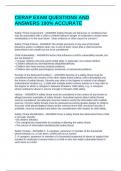CERAP EXAM QUESTIONS AND
ANSWERS 100% ACCURATE
Safety Threat Assessment - ANSWER-Safety threats are behaviors or conditions that
may be associated with a child or children being in danger of moderate to severe harm
immediately or in the near future. "clear evidence or other cause for concern."
Safety Threat Criteria - ANSWER-The simple presence of any one of the listed
behaviors and/or conditions does not, in and of itself, mean that a child should be
determined to be unsafe but are to be considered!
Child Vulnerability: - ANSWER-Factors that influence a child's vulnerability include, but
are not limited to:
• Younger children who lack good verbal skills, in particular, non-verbal children.
• Children affected by developmental disabilities/deficits.
• Children who have serious medical problems.
• Children who exhibit psychological, emotional, or behavioral problems.
Severity of the Behavior/Condition: - ANSWER-Severity of a safety threat must be
considered within the context of the other safety threat criteria, child vulnerability and
the history of safety threats. Severity may refer to the degree or extend of an alleged
maltreatment incident e.g., a child with multiple and/or serious injuries or it may refer to
the degree to which a caregiver's behavior threatens child safety, e.g., a caregiver
whose substance abuse is severe enough to threaten child safety.
History: - ANSWER-A safety threat must be considered in the context of any known or
alleged previous examples of safety threats. Anecdotal reports about safety threats
must be considered, but attempts must be made to verify the information with credible
sources. Chronic safety threats must be assessed as posing greater danger to children.
Any prior child abuse/neglect history and/or criminal arrest and conviction records, if
available, must be evaluated and taken into consideration with respect to child safety.
Safety Threat Identification - ANSWER-Once a safety threat has determined that a child
is not safe, identify:
• All children affected.
• The caregiver(s) responsible for creating or allowing the safety threat.
• The source of information identifying the safety threat.
Safety Threats - ANSWER-1. A caregiver, paramour or member of the household
whose behavior is, or has been, violent and out of control.
2. A caregiver, paramour or member of a household suspected of abuse or neglect that
resulted in moderate to severe harm to a child or who has made a plausible threat of
such harm to a child.
, 3. A caregiver, paramour or member of the household who has a documented history of
perpetrating child abuse/neglect or any person for whom there is a reasonable cause to
believe that he/she previously abused or neglected a child. The severity of that
maltreatment, coupled with the caregiver's failure to protect, suggests that child safety
may be an urgent and immediate concern.
4. Child sexual abuse is suspected and circumstances suggest that child safety may be
an immediate concern.
5. A caregiver, paramour or member of the household is hiding the child, refuses
access, or there is some indication that a caregiver may flee with the child.
6. Child is fearful of his/her home situation because of the people living in or frequenting
the home.
7. A caregiver, paramour, or member of the household describes or acts toward the
child in a predominantly negative manner.
8. A caregiver, paramour, or member of the household has dangerously unrealistic
expectations for the child.
9. A caregiver, paramour or member of the household expresses credible fear that
he/she may cause moderate to severe harm to a child.
10. A caregiver, paramour or member of the household has not, will not, or is unable to
provide sufficient supervision to protect a child from potentially moderate to severe
harm.
11. A caregiver, paramour or member of the household refuses to or is unable to meet a
child's medical or mental health care needs and such lack of care may result in
moderate to severe harm to the child.
12. A caregiver, paramour or member of the
A caregiver, paramour, or member of the household describes or acts toward the child
in a predominantly negative manner. - ANSWER-Examples of such include, but are not
limited to: • Describing a child in demeaning or degrading terms, such as evil, stupid,
ugly, a liar, a thief, etc.
• Cursing at a child in a demeaning, degrading, and/or hostile manner.
• Using a particular child as a scapegoat.
A caregiver, paramour, or member of the household has dangerously unrealistic
expectations for the child. - ANSWER-Examples of such include, but are not limited to:
• The child is expected to perform or act in a way that is impossible or
improbable for the child's age, e.g., babies and toddlers expected not to cry or to be still
for extended periods; young children to be toilet trained, eat neatly or take responsibility
beyond their years.
• Appearing to interpret child's non-compliance as defiance of caregiver/paramour's
authority.
A caregiver, paramour or member of the household expresses credible fear that he/she
may cause moderate to severe harm to a child. - ANSWER-Examples of such behavior
include, but are not limited to:
• The caregiver making a credible statement that he/she may seriously harm a child.




